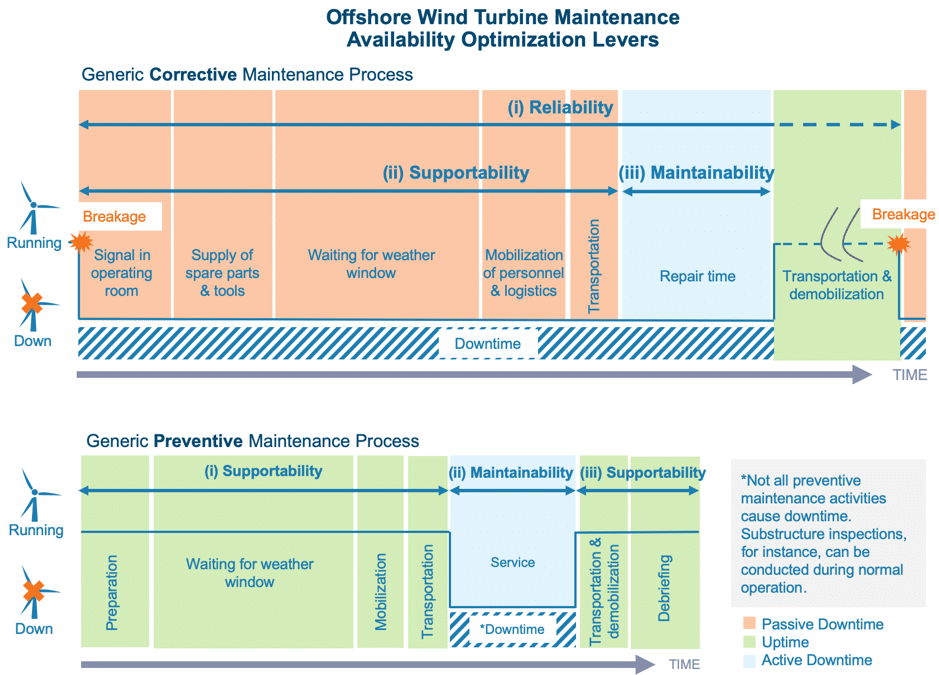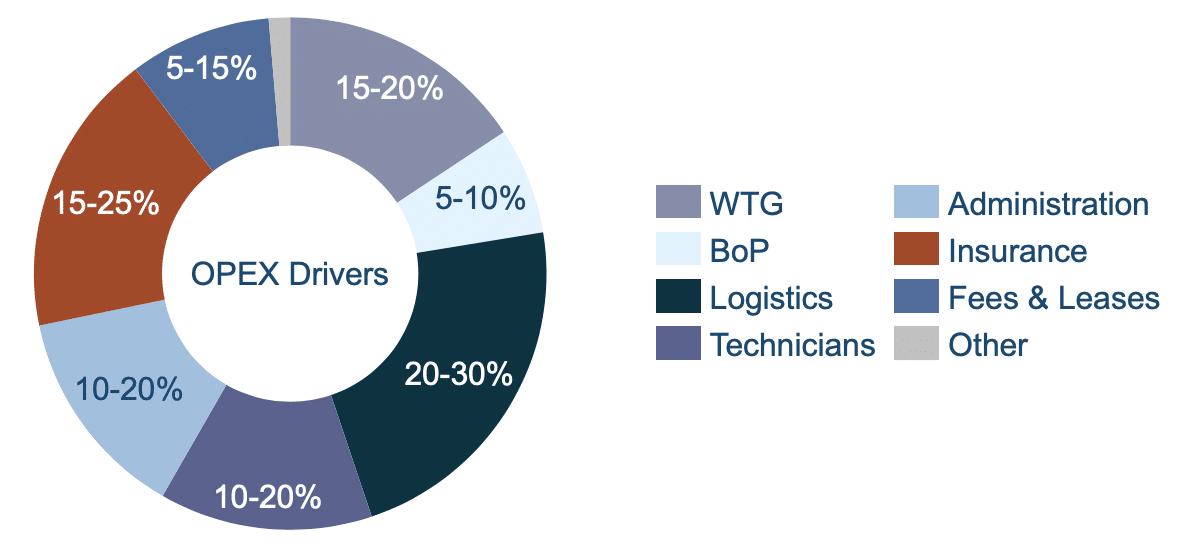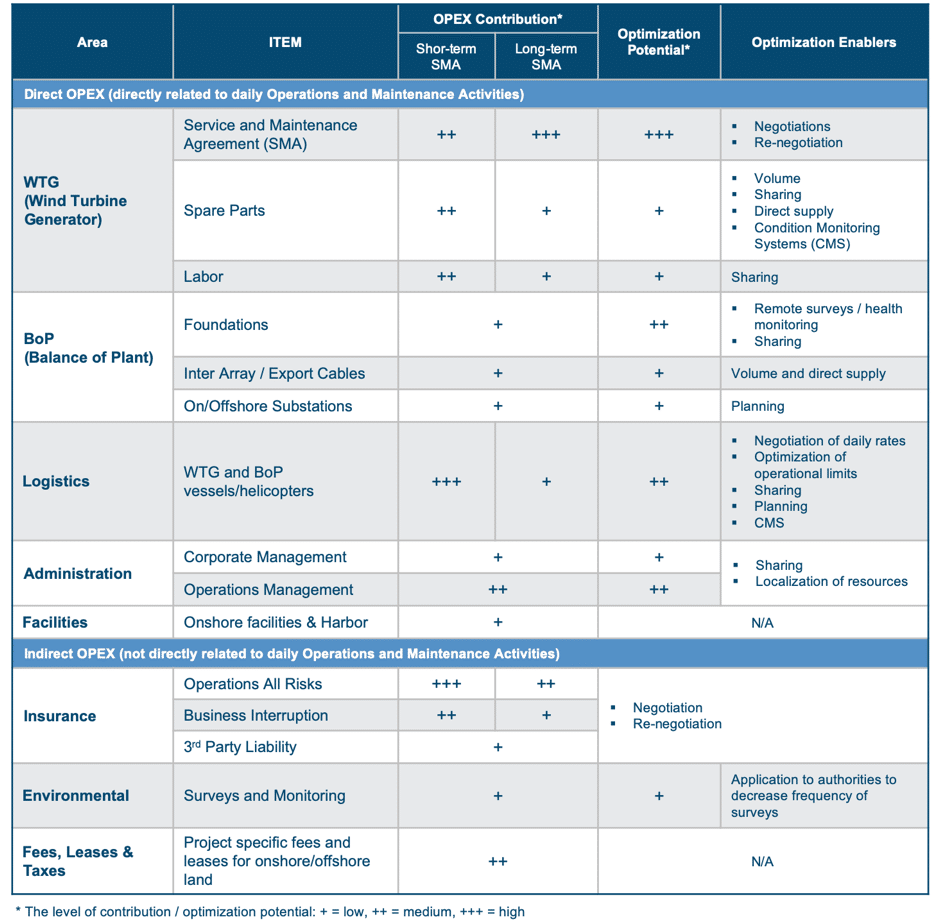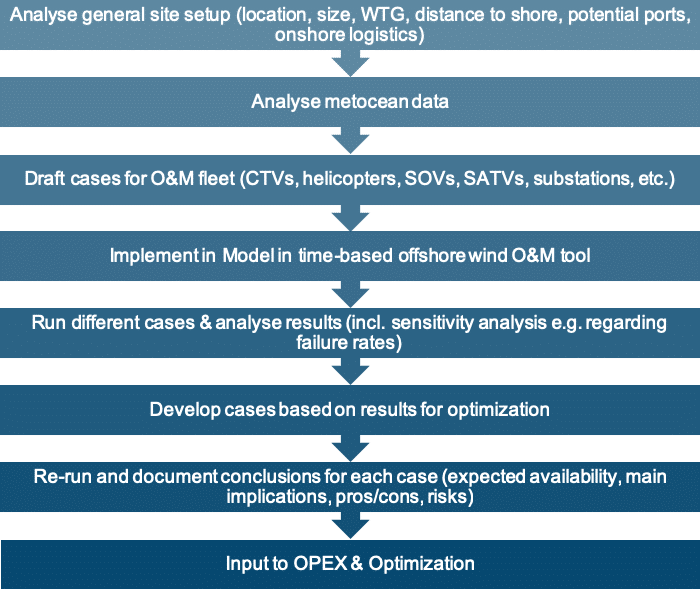This article focuses on finding the optimal balance between OPEX (Operational Expenditures) and production-based availability of offshore wind assets.
Why read this article?
(Almost) all revenues over the life cycle of an offshore wind farm are generated through the sale of electricity. This means that high asset availability, i.e. the electricity generated over the theoretically producible, is an inherent goal in operation – while one should make sure that the cost involved with enabling it is lower than the revenue gains realised. This article outlines some basics for enabling an understanding of the enablers of availability as well as OPEX drivers to balance both.
Wind farm availability is enabled by reliability, supportability and maintainability of the asset.
In periods of un-availability, downtime origins from preparation and execution of preventive and corrective maintenance activities. Corrective maintenance (repair or replacement of minor and major components) contributes between 1.5 % and 3 % downtime to state-of-the-art wind farms – values can be higher during run-in periods (first years of operations). Preventive maintenance campaigns usually contribute around 0.5 % time-based downtime (impact on production-based availability can be optimized when conducted in low-wind periods). Figure 1 summarizes the main mechanisms around availability – explanations are provided in the subsequent sections.

Figure 1: The enablers of availability: reliability, supportability and maintainability
(i) Reliability is defined as the “ability of an item to perform a required function under given conditions for a given time interval”. In other words: if a wind turbine would continuously deliver the power output as required, reliability and availability would be at 100 %. In reality, this is not the case – we are observing several interruptions of offshore wind turbine operations due to, e.g., errors in the control system, wear out of minor components but also breakdown of large components such as gearboxes, generators or blades.
While reliability figures can be estimated at high confidence levels for wind turbine platforms that have been in operation for several years, there is a high level of uncertainty in the corresponding numbers for new models and alternative technology (such as floating substructure concepts). It is therefore key to use existing experience to the best possible degree and to reflect the corresponding uncertainties by targeted sensitivity analyses.
Asset reliability can be influenced by a robust, fault tolerant and redundant system design as well as appropriate preventive maintenance schedules, condition monitoring systems and plans that allow for failure avoidance and early failure detection.
(ii) Supportability is defined as the “ability of a maintenance organization to have the correct maintenance support at the necessary place to perform the required maintenance activity when required”. For the offshore wind sector in particular, supportability is to a large extent restricted by access limitations for crew transfer and support vessels and helicopters. One of the key tasks in the development of O&M strategies for offshore wind farms is therefore to develop a suitable offshore logistics concept that can cater for the required offshore interventions and avoids long downtime periods.
Supportability can be influenced by a strong site-specific logistics setup that considers the anticipated workload with contingencies and state-of-the-art logistics solutions allowing for a good asset accessibility. Tailored supply chain contracts mainly related to skilled technicians, but also spare parts and tools enhance an efficient O&M setup with respect to supportability aspects.
(iii) Maintainability is defined as the “ability of an item under given conditions of use, to be retained in, or restored to, a state in which it can perform a required function, when maintenance is performed under given conditions and using stated procedures and resources”. Modern wind turbines allow, for instance, for remote re-sets of control systems – an ability that significantly reduces downtime as most failures related to the control systems only cause limited downtime. Another example is modular design that allows for replacement of single components rather than large assemblies and in turn reducing the requirements towards offshore logistics.
Maintainability is to a great extent determined during the wind turbine design phase. Here, it is key that O&M reviews take place that consider feasible efficient works to be carried out on the turbines. Offshore substations but also wind turbine foundations should be designed considering the requirements for future O&M activities (e.g. avoiding regular diving activities).
The enablers of availability are repeated below:
Achieving high asset availability in offshore wind comes at a cost.
It requires investment into suitable wind turbines and balance of plant items but also the creation of a well-functioning operating organization, access to suitable means of logistics, skilled technicians, tools and technology as well as contingency plans potentially supported by framework agreements with supply chain partners. The following part sheds light on the main cost drivers particularly related to operational expenditures (OPEX). It shall inform the reader about which numbers carefully to assess when balancing cost and availability in offshore wind projects. It also gives an indication as to where the highest OPEX optimization potentials are typically located.

Figure 2. OPEX drivers. “Other” includes Facilities and Environmental costs.
Figure 2 and Table 1 provide an overview of the main OPEX drivers to be expected in a typical offshore wind farm. In Figure 2, OPEX related to the WTG (Wind Turbine Generator – the wind turbine itself and the tower) and BoP (Balance of Plant – substructures, foundations, substations and cabling) have been divided into direct cost and those related to technical resources (separate section “Technicians”) as well as logistics. Additionally, the overview shows OPEX ranges for administration, insurances, fees, leases and other costs. Table 1 provides more details on the individual cost items within each group as well as their optimization potential.
Experience within offshore wind shows that Service and Maintenance Agreement (SMA), Logistics and Insurance costs can represent more than 50% of total lifetime OPEX. The optimization potential of SMA, Logistics and Insurance costs range from medium to high, and the enablers would be focused on negotiation/re-negotiation strategies with the suppliers. It shall be noted that a short-term SMA is usually between 2 and 5 years while long-term SMAs can reach up to 15-20 years. The optimization potential through SMA negotiations is proportional to the duration of the contract while the focus is on optimizing the in-house organization for short- and medium-term SMAs. Opportunities of sharing logistics with other sites would also be one of the priorities in order to optimize logistics costs. Administration costs can also become a main driver when it comes to small sites.
Regarding other OPEX drivers, it is observed that organizations are often able to achieve cost reductions over the lifetime by delivering tasks and services more efficiently. Those efficiencies are typically highest in preventive maintenance campaigns (i.e. the tasks are conducted faster over time) and in the on-site organization (i.e. the administrative core team requires more support in early years of operation before processes are matured). Such process maturation (technical, financial, commercial, legal) is also observed for corrective maintenance campaigns, the use of offshore logistics and general cost drivers which leads to additional cost saving potentials over the lifetime.
The Lifetime OPEX profile will be very different from project to project, and so will be the optimization potential and optimization enablers. Site-specific considerations mainly depend on:
- Market conditions (maturity, level of competence, localization/regulatory requirements)
- Site conditions (available harbours and distance, wave height, weather, etc.)
- Owners’ risk-appetite (hands-on and active approach vs outsourcing strategy)
- Existent neighbours’ sites and synergy opportunities
- Technology available at the moment of development/operations
- Increase in options of suppliers/service providers that lead to more attractive offers
- Negotiation power of the owner

Table 1. Overview of typical OPEX drivers for short- and long-term Service and Maintenance Agreement (SMA)
Each wind farm has its own OPEX sensitivity to the different items based on the characteristics mentioned above, and therefore the optimization potential might vary. Moreover, the OPEX cannot be taken as a standalone parameter, but it must be seen in conjunction with availability levels and other factors. The optimal balance between OPEX and availability will most likely change during the wind farm lifetime as electricity price or other important parameters can change. The following section outlines an approach for optimizing availability and OPEX levels.
Balancing OPEX and availability is a key activity in offshore wind farm development.
The first step in O&M (Operations and Maintenance) strategy development is a site review. This entails assessment of onshore infrastructure (harbours, roads, storage facilities, office spaces, grid connection points, onshore substations, etc.) as well as offshore conditions (mainly wind and wave time series, visibility and daylight tables). This is followed by a review of the planned site (number and type of wind turbines and foundations, offshore substations, array and export cables).
Those data serve as a basis for drafting the first feasible site setups (e.g. using a preferred harbour, selection of a certain number of crew transfer or service operation vessels, helicopters and jack-up vessels). The distance to shore and met-ocean conditions give an indication as to whether a shore-based or offshore-based logistics strategy is most appropriate. Optimally, one can draw upon experience when developing cases of alternative site setups.
The cases developed should subsequently be represented in a suitable computer model. There are several commercial tools available on the market – PEAK Wind relies on a proven in-house solution. For any simulation environment used, it is essential that the site conditions that restrict access are represented adequately. I.e., suitable weather windows available for offshore interventions of different types must be as close to the expected as possible. When representing wind turbines in the model, the most critical aspect is to represent realistic reliability data (failure rates). The number and type of intervention required is the essential information determining whether an O&M organization (incl. the means of logistics) is capable to efficiently enable high asset availability. It is important to note that the use of new wind turbine platforms, for which real failure rates have not been retrieved yet, should be analysed using an envelope of high and low failure rates in order to assess the sensitivity of a site towards changes in expected reliability. The main steps required to assess different site setups is drafted in Figure 3 below.

WTG = Wind Turbine Generator
O&M = Operations and Maintenance
CTV = Crew Transfer Vessel
SOV = Service Operations Vessel
SATV = Service Accommodation and Transfer Vessel
OPEX = Operational Expenditures
Figure 3: Offshore wind farm O&M site assessment
The essential output of the availability assessment described above is the expected energy yield for different site layouts – whereby the driving parameters are service port location, logistics setup (O&M fleet) and wind turbine reliability. Considering the feed-in tariff and balance of plant availability, the availabilities can be calculated into monetary revenues.
The different parameters are collected for each of the cases and fed into a holistic OPEX model. Here, a “price tag” is allocated to each of the cases analysed. PEAK Wind uses a proven in-house OPEX model and benchmarking tool to compare the cost (and risk) implications of each scenario. Using both, expected revenues and OPEX figures, optimal site setups can be defined. This is illustratively shown in Figure 4 below.

Figure 4: Balance of OPEX and availability / revenue
The procedure described above may be updated throughout the project development (and even operational) phase and refined with new, more accurate input data. Costs for contractors or service agreements often change during development as service providers reduce margins for uncertainties once the project is maturing.
Keep in mind:
Achieving high asset availability is a key success criterion for the operation of offshore wind farms. However, one should make sure that the revenues realized through high availabilities are balanced with the cost required to achieve them. I.e., it is not the target to achieve the highest practicable availability, but to find the optimal balance between availability and OPEX.
Want to learn more about successful operations?
Just reach out to us, we are always happy to answer your questions and get into discussions on optimized operations and asset management!
Dr Matti Niclas Scheu | Director of Sales and Partnerships | Get in touch
